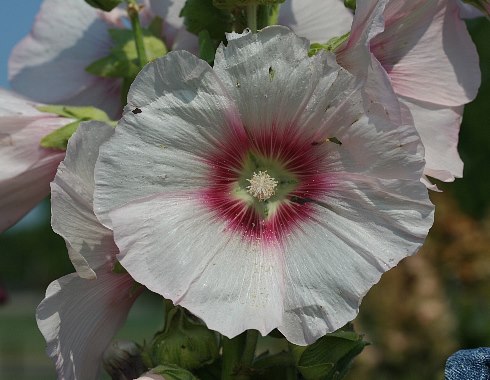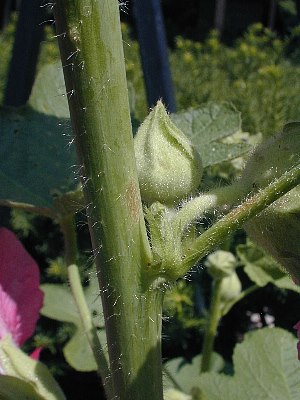Description: This herbaceous plant is a biennial or short-lived perennial that becomes 4-8' tall. The stout central stem is unbranched or sparingly branched; it is light green, terete, and more or less hairy. The blades of the alternate leaves are up to 8" long and across; they are palmately lobed (with 3-7 blunt lobes each) and crenate along their margins. Each leaf blade is orbicular or oval in outline and indented at the base where the petiole joins the blade. The upper surface of each leaf blade is medium green, slightly pubescent to hairless, and wrinkled from fine veins; the lower surface is light green and pubescent. The petioles of the leaves are as long or a little longer than their blades; they are light green and hairy.

The central stem
terminates in a spike-like raceme of flowers; axillary flowers are
produced from the axils of the upper leaves as well. These flowers
occur individually or in small clusters along the central stem; they
nod sideways from short hairy pedicels. Each flower spans about 3-5"
when it is fully open; it has 5 petals, 5 sepals, 6-9 sepal-like
bracts, and a columnar structure in the center with the reproductive
organs (stamens toward the tip, thread-like stigmas below). The
overlapping petals provide the flower with a funnelform shape; they are
usually some shade of white, pink, or purplish red. The sepals are
light green, ovate, and much smaller than the petals. The bracts of
each flower are located underneath the sepals; they are light green,
hairy, ovate, and joined together at the base. The blooming period
occurs from mid-summer into the fall; a colony of plants will bloom for
about 2 months. Each flower is replaced by a fruit containing a ring of
15-20 seeds (technically, a schizocarp). These seeds are oval,
flattened, and notched on one side. The root system consists of a
taproot. This plant spreads by reseeding itself.
Cultivation:
The preference is full to partial sun, moist to mesic conditions, and a
fertile loamy soil. Lower leaves will wither away during hot dry
weather. Hollyhock is vulnerable to foliar disease, including rust.
Range & Habitat:
The non-native Hollyhock occasionally escapes from cultivation, but it
rarely persists.
Escaped plants have been collected primarily in NE and east central
Illinois (see Distribution
Map). Habitats include areas along railroads, roadsides,
vacant lots, and waste areas, especially in urban areas. Areas with a
history of disturbance are preferred. Because of the showy flowers,
Hollyhock is often cultivated in gardens. It is native to Eurasia.
Faunal Associations:
The flowers are cross-pollinated by several kinds of bees. Various
insects feed on the leaves and other parts of Hollyhock. These include
caterpillars of Pyrgus communis (Common Checkered
Skipper), caterpillars of the butterflies Vanessa cardui
(Painted Lady) and Strymon melinus (Gray
Hairstreak), and caterpillars of such moths as Acontia aprica
(Exposed Bird-Dropping Moth), Anomis erosa (Yellow
Scallop Moth), Autographa precationis (Common
Looper Moth), Mamestra configurata (Bertha
Armyworm), and Astrotischeria
omissa (Bouseman et al., 2006; Wagner, 2005; Covell,
1984/2005; Needham et al., 1928). Other insects that feed on Hollyhock
include both adults and larvae of Apion
longirostre (Hollyhock Weevil), adults of Popillia
japonica
(Japanese Beetle), Acyrthosiphon
malvae (Geranium Aphid) and Aphis gossypii
(Cotton Aphid), Brooksetta
althaeae (Hollyhock Plant Bug), and larvae of the flies Calycomyza malvae
and Melanagromyza
hicksi (Cranshaw, 2004; personal observation; Blackman
& Eastop, 2013; Pepper, 1965; Knight, 1941; Spencer &
Steyskal, 1986). The foliage is palatable to cattle and other hoofed
mammalian herbivores.
Photographic Location:
The photograph of the flower was taken at The Arboretum in Urbana,
Illinois;
the photographs of the stem and leaf were taken at a flower garden of
the same city.

Comments: The meaning of the common name is probably 'Holy Mallow.' Hollyhock is one of the taller members of the Mallow family. It superficially resembles one of the native Hibiscus spp. (Rose Mallows), which are perennial wetland plants. Hollyhock differs in having floral bracts that are ovate, while a Rose Mallow has floral bracts that are narrowly linear. The structures of their fruits also differ: the fruit of Hollyhock consists of a ring of seeds, while the fruit of Rose Mallow is a 5-celled capsule. Some of the taller Malva spp. (Mallows) also resemble Hollyhock, but they have only 1-3 bracts per flower; Hollyhock has 6-9 bracts per flower. An alternative scientific name for this species is Althaea rosea.